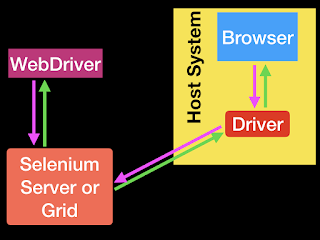Understanding WebDriver Components
[UPDATE] This post is based on a submission I made to the official WebDriver documentation in early Spring of 2018. It's meant to help folks understand how pieces and parts fit together for WebDriver.
[/]
Building a test suite using WebDriver will require you to understand and effectively use a number of different components. As with everything in software, different people use different terms for the same idea. Below is a breakdown of how terms are used in this description.
Terminology
- API: Application Programming Interface. This is the set of "commands" you use to manipulate WebDriver.
- Library: A code module which contains the APIs and the code necessary to implement them. Libraries are specific to each language binding, eg .jar files for Java, .dll files for .NET, etc.
- Driver: Responsible for controlling the actual browser. Most drivers are created by the browser vendors themselves. Drivers are generally executable modules that run on the system with the browser itself, not on the system executing the test suite. (Although those may be the same system.) NOTE: Some people refer to the drivers as proxies.
- Framework: An additional library used as a support for WebDriver suites. These frameworks may be test frameworks such as JUnit or NUnit. They may also be frameworks supporting natural language features such as Cucumber or Robotium. Frameworks may also be written and used for things such as manipulating or configuring the system under test, data creation, test oracles, etc.
The Parts and Pieces
At its minimum, WebDriver talks to a browser through a driver. Communication is two way: WebDriver passes commands to the browser through the driver, and receives information back via the same route.
The driver is specific to the browser, such as ChromeDriver for Google's Chrome/Chromium, GeckoDriver for Mozilla's Firefox, etc. The driver runs on the same system as the browser. This may, or may not be, the same system where the tests themselves are executing.
This simple example above is
direct communication. Communication to the browser may also be
remote communication through Selenium Server or RemoteWebDriver. RemoteWebDriver runs on the same system as the driver and the browser.
Remote communication can also take place using Selenium Server or Selenium Grid, both of which in turn talk to the driver on the host system
Where Frameworks Fit In
WebDriver has one job and one job only: communicate with the browser via any of the methods above. WebDriver doesn't know a thing about testing: it doesn't know how to compare things, assert pass or fail, and it certainly doesn't know a thing about reporting or Given/When/Then grammar.
This is where various frameworks come in to play. At a minimum you'll need a test framework that matches the language bindings, eg NUnit for .NET, JUnit for Java, RSpec for Ruby, etc.
The test framework is responsible for running and executing your WebDriver and related steps in your tests. As such, you can think of it looking akin to the following image.
The test framework is also what provides you asserts, comparisons, checks, or whatever that framework's vernacular for the actual test you're performing, eg
AssertAreEqual(orderTotalAmount, "$42");
Natural language frameworks/tools such as Cucumber may exist as part of that Test Framework box in the figure above, or they may wrap the Test Framework entirely in their own implementation.
Natural language frameworks enable the team to write tests in plain English that help ensure clarity of
why you are building something and
what it is supposed to do, versus the very granular
how of a good unit test.
If you're not familiar with specifications, Gherkin, Cucumber, BDD, ATDD, or whatever other soup-of-the-day acronym/phrase the world has come up with, then I encourage you to go find a copy of
Specifications By Example. It's a wonderful place to start. You should follow that up with
50 Quick Ideas to Improve Your User Stories, and
50 Quick Ideas to Improve Your Tests, both by Gojko Adzjic.
Following Up
Don't stop here. Go learn more about how WebDriver works. Read the
WebDriver documentation. Sign up for Dave Haeffner's awesome
Elemental Selenium newsletter and read his past articles.
Join the
Slack Channel and ask questions. (But please, do yourself and the Selenium community a favor and first do a little research so you're asking questions in a fashion that can help others best respond!)




